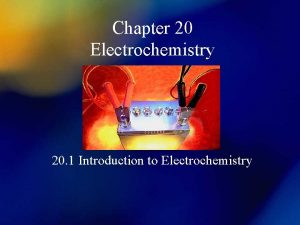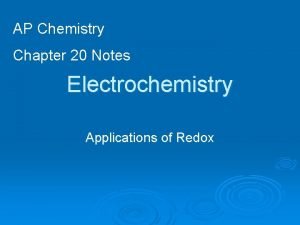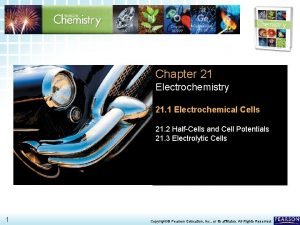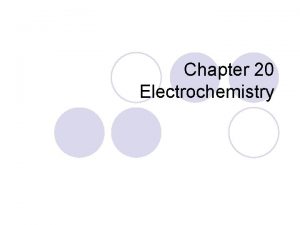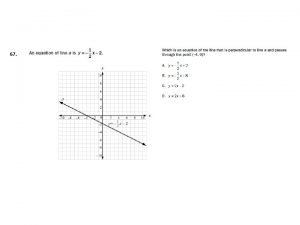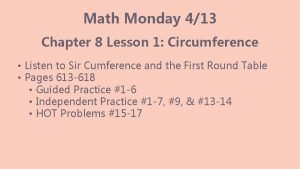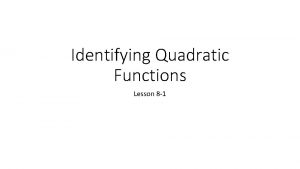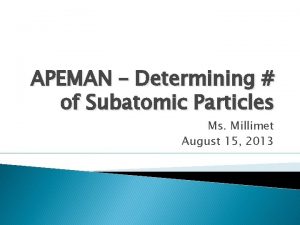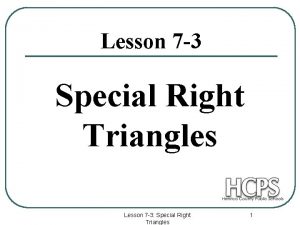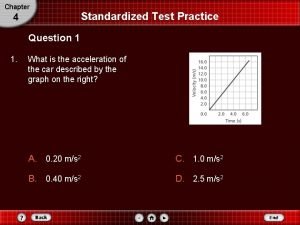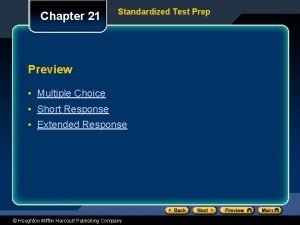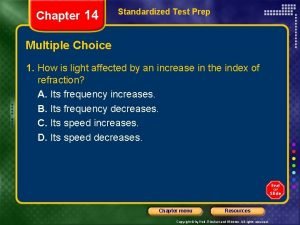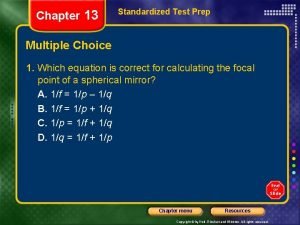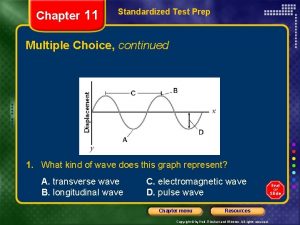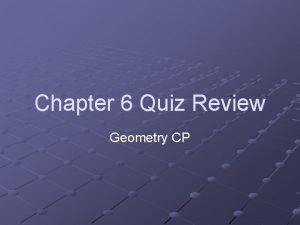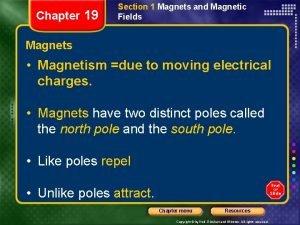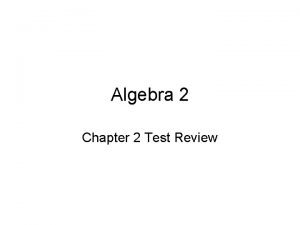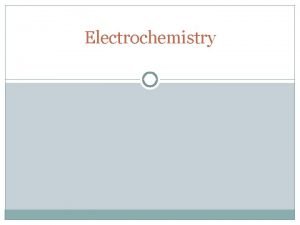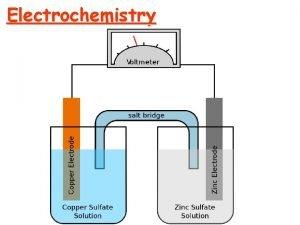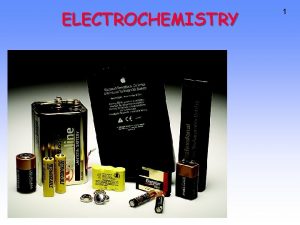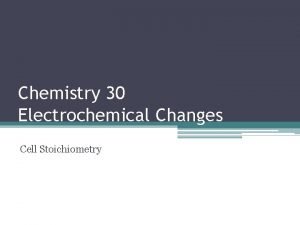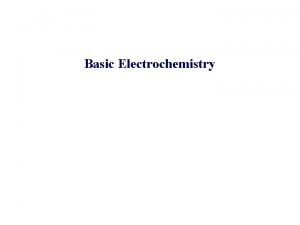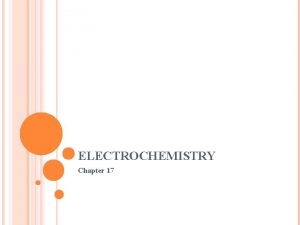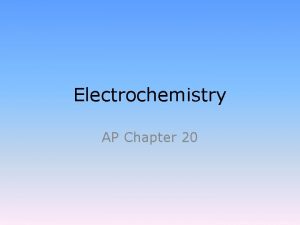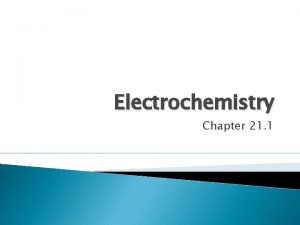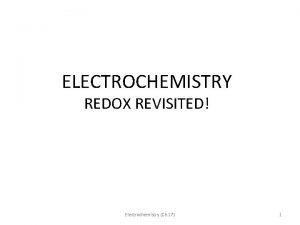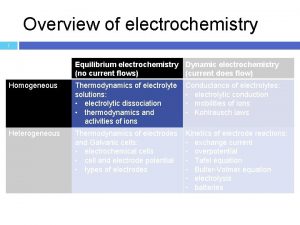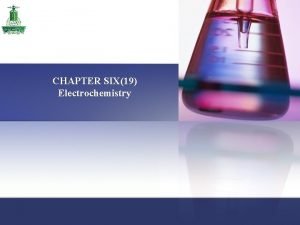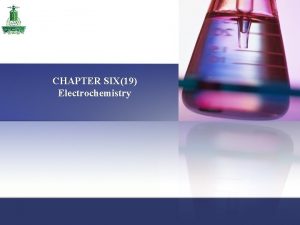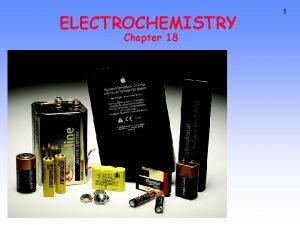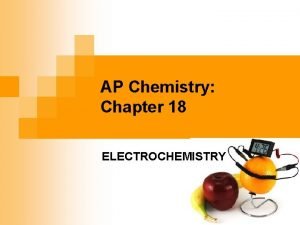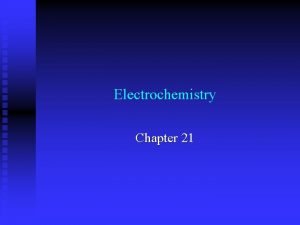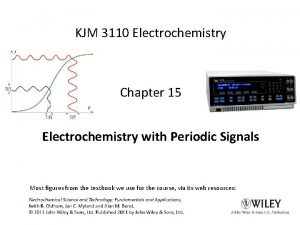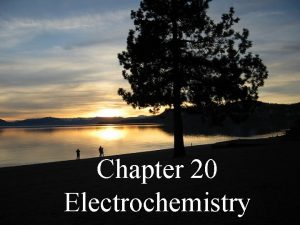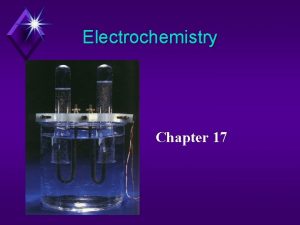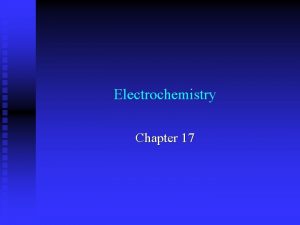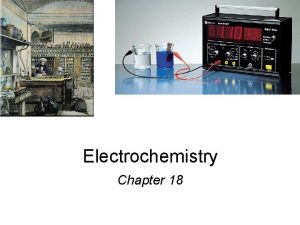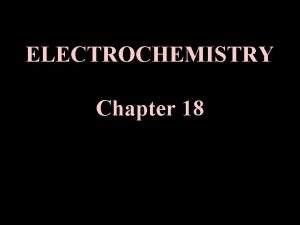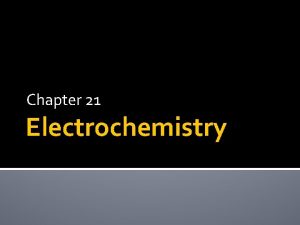Electrochemistry homework Chapter 18 Electrochemistry AP Practice test










































- Slides: 42

Electrochemistry

homework • Chapter 18 • Electrochemistry • AP Practice test

Oxidation- Reduction Reactions • Redox or oxidation-reduction reactions are reactions that involve a transfer of electrons. • Oxidation is the loss of electrons. • Reduction is the gain of electrons. • (think of the charge, OIL RIG) • So in the reaction • 4 K + O 2 → 4 K+ + 2 O 2 • Potassium get oxidized, oxygen get reduced

Oxidation States • Oxidation state is theoretical charge on all atoms if all bonds were ionic. • The sum of the oxidation states must be equal to the charge of the ion or molecule.

Using oxidation states • In the reaction… • 2 Na +2 H 2 O → 2 Na. OH + H 2 • 0 +1 -2 +1 0 • Note the changes • Sodium went from 0 to 1 • 2 of the hydrogen atoms went from +1 to 0 (the other two were unchanged)

Identification of Redox Components. • Specify which of the following equations represents oxidation-reduction reactions, and indicate the oxidizing agent, the reducing agent, the species being oxidized, and the species being reduced. • • CH 4(g) + H 2 O(g) CO(g) + 3 H 2(g) • 2 Ag. NO 3(aq) + Cu(s) Cu(NO 3)2(aq) + 2 Ag(s) • 2 H+(aq) + 2 Cr. O 42 -(aq) Cr 2 O 72 -(aq) + H 2 O(l)

• CH 4(g) + H 2 O(g) CO(g) + 3 H 2(g) • -4 +1 +1 -2 +4 -2 0 • C is oxidized, and H is reduced • C is reducing agent, H is oxidizing agent • 2 Ag. NO 3(aq) + Cu(s) Cu(NO 3)2(aq) + 2 Ag(s) • +1 +5 -2 0 +2 +5 -2 0 • Ag is reduced, Cu is oxidized • Ag is oxidizing agent, Cu is reducing agent • Net Ionic • 2 Ag+(aq) + Cu(s) Cu 2+ (aq) + 2 Ag(s) • +1 0 +2 0 • Ag is reduced, Cu is oxidized • 2 H+(aq) + 2 Cr. O 42 -(aq) Cr 2 O 72 -(aq) + H 2 O(l) • +1 +6 -2 +1 -2 • This is not a redox reaction

Half reactions • Ce 4+ + Sn 2+ → Ce 3+ + Sn 4+ • Half reactions • Ce 4+ + e- → Ce 3+ • Sn 2+ → 2 e- + Sn 4+ • Electrons lost must equal electrons gained! • 2 Ce 4+ +2 e- → 2 Ce 3+ • Merge the two half reactions • 2 Ce 4+ + Sn 2+ → 2 Ce 3+ + Sn 4+

Redox reactions in acidic solutions • It will be noted in the problem • Balance all elements except hydrogen and oxygen. • Balance oxygen by adding H 2 O (which is always prevalent in an acidic solution) • Balance hydrogen by adding H+ • Then balance the charge adding electrons and proceed normally.

Example • In an acidic solution • Cr 2 O 7 2 - + Cl- → Cr 3+ + Cl 2 • Half reactions • Cr 2 O 7 2 - → Cr 3+ • Cl- → Cl 2

Reduction side • Cr 2 O 7 2 - → Cr 3+ • Cr 2 O 7 2 - → 2 Cr 3+ + 7 H 2 O • Cr 2 O 7 2 - + 14 H+→ 2 Cr 3+ + 7 H 2 O • Cr 2 O 7 2 - + 14 H++ 6 e- → 2 Cr 3++7 H 2 O

Oxidation side • Cl- → Cl 2 • 2 Cl- → Cl 2 + 2 e • I have to equal 6 e- so multiply by 3 • 6 Cl- → 3 Cl 2 + 6 e-

Combine my half reactions • Cr 2 O 7 2 - + 14 H++ 6 e- → 2 Cr 3+ + 7 H 2 O • 6 Cl- → 3 Cl 2 + 6 e • And you get • Cr 2 O 7 2 -+14 H++6 Cl-→ 2 Cr 3++3 Cl 2+7 H 2 O • The electrons cancel out.

Example • In an acidic solution • Mn. O 4 - + H 2 O 2 → Mn 2+ + O 2 • Half reactions • Mn. O 4 - → Mn 2+ • H 2 O 2 → O 2

Top Equation • Mn. O 4 - → Mn 2+ + 4 H 2 O • Mn. O 4 - + 8 H+→ Mn 2+ + 4 H 2 O • Mn. O 4 - + 8 H++ 5 e-→ Mn 2+ + 4 H 2 O

Bottom Equation • H 2 O 2 → O 2 + 2 H + + 2 e • I need to equal 5 e- so… • That won’t work… • 2 Mn. O 4 - + 16 H++ 10 e-→ 2 Mn 2+ + 8 H 2 O • 5 H 2 O 2 → 5 O 2 + 10 H+ + 10 e-

Add them together • 2 Mn. O 4 - + 16 H++ 10 e-→ 2 Mn 2+ + 8 H 2 O • 5 H 2 O 2 → 5 O 2 + 10 H+ + 10 e • And you get • 2 Mn. O 4 - + 6 H++ 5 H 2 O 2 → 2 Mn 2+ + 5 O 2 + 8 H 2 O • Notice the H+ canceled out as well.

Balancing Redox Equations in a basic solution • Look for the words basic or alkaline • Follow all rules for an acidic solution. • After you have completed the acidic reaction add OH- to each side to neutralize any H+. • Combine OH- and H+ to make H 2 O. • Cancel out any extra waters from both sides of the equation.

Example • We will use the same equation as before • In a basic solution • Mn. O 4 - + H 2 O 2 → Mn 2+ + O 2 • 2 Mn. O 4 - + 6 H++ 5 H 2 O 2 → 2 Mn 2+ + 5 O 2 + 8 H 2 O

Basic solution • Since this is a basic solution we can’t have excess H+. • We will add OH- to each side to neutralize all H+ • 2 Mn. O 4 - + 6 H++ 5 H 2 O 2 + 6 OH→ 2 Mn 2+ +5 O 2 +8 H 2 O + 6 OH • We added 6 OH- because there were 6 H+

Cont. • H+ + OH- → H 2 O • Combine the hydroxide and hydrogen on the reactant side to make water • 2 Mn. O 4 - + 6 H 2 O + 5 H 2 O 2 → 2 Mn 2++ 5 O 2+ 8 H 2 O + 6 OH • Cancel out waters on both sides 2 Mn. O 4 - + 5 H 2 O 2 → 2 Mn 2+ + 5 O 2 +2 H 2 O +6 OH-

Another example • In a basic solution • Mn. O 4 − + SO 32 -→Mn. O 4 2− + SO 42 • Half reactions • Mn. O 4 − → Mn. O 4 2− • SO 32 -→ SO 42 -

Half reactions • Mn. O 4 − → Mn. O 4 2− • Mn. O 4 - + e- → Mn. O 4 2− • SO 32 -→ SO 42 • H 2 O + SO 32 -→ SO 42 - + 2 H+ +2 e • Double the top reaction

• 2 Mn. O 4 - + 2 e- → 2 Mn. O 4 2− • H 2 O + SO 32 -→ SO 42 - + 2 H+ +2 e • Combine them • 2 Mn. O 4 - + H 2 O + SO 32→ 2 Mn. O 4 2− +SO 42 - + 2 H+ • Add OH 2 Mn. O 4 - + H 2 O + SO 32 - + 2 OH→ 2 Mn. O 4 2−+SO 42 - +2 H++2 OH-

• 2 Mn. O 4 - + H 2 O + SO 32 - + 2 OH→ 2 Mn. O 4 2− +SO 42 - + 2 H 2 O • finishing • 2 Mn. O 4 - + SO 32 - + 2 OH→ 2 Mn. O 4 2− +SO 42 - + H 2 O

Major Redox Points to Remember. • Any redox reaction can be treated as the sum of the reduction and oxidation halfreactions. • Mass (atoms) and charge are conserved in each half-reaction. • Electrons lost in one half-reaction are gained in the other. • Even though the half-reactions are treated separately, electron loss and electron gain occur simultaneously.

Galvanic Cell

Galvanic cell • A galvanic cell is a device in which chemical energy is changed to electrical energy. • A galvanic cell uses a thermodynanamically favored or spontaneous redox reaction to produce an electric current that can be used to do work. The system does work on the surroundings. • A redox reaction involves the transfer of electrons from the reducing agent to the oxidizing agent.

Oxidation v reduction • Oxidation. • * Involves a loss of electrons. • * Increase in oxidation number. • * “To get more positive. ” • * Occurs at the anode of a galvanic cell. • An Ox • Reduction. • * Involves a gain of electrons. • * Decrease in oxidation number. • * “To get more negative. ” • * Occurs at the cathode of a galvanic cell. • Red Cat

Production of Current • Oxidation Reactions involve a transfer of electrons. • Electric current is a movement of electrons. • In order to produce a usable current, the electrons must be forced across a set path (circuit). • In order to accomplish this, an oxidizing agent and something to oxidize must be separated from a reducing agent with something to reduce.

Pictures oxidation reduction Oxidation • Oxidation reduction reaction in the same container will have electrons transferring, but we can’t harness them. • Separating the oxidation reaction from the reduction reaction, but connecting them by a wire would allow only electrons to flow. Reduction

Closer look X → X+ + e. Oxidation X+ + e- → X Reduction • We now have excess electrons being formed in the oxidizing solution and a need for electrons in the reducing solution with a path for them to flow through. • However, if electrons did flow through the wire it would cause a negative and positive solution to form.

That’s not possible • Or at least it would require a lot of energy. • A negative solution would theoretically be formed by adding electrons, and a positive one by removing electrons. • The negative solution would then repel the electrons and stop them from flowing in, and a positive solution would attract the electrons pulling them back where they came from. • Making it so the charged solutions wouldn’t form. • In order for this to work, I would need a way for ions to flow back and forth but keeping the solutions mostly separated.

The Salt Bridge or the Porous Disk. • These devices allow ion flow to occur (circuit completion) without mixing the solutions. They are typically made of sodium sulfate or potassium nitrate

Closer look e- X → X+ + e. Oxidation e- e- Salt Bridge X+ + e- → X Reduction • Now electrons can flow across the wire from the oxidation reaction to the reduction reaction. • As the oxidation reaction becomes positive, it removes negative ions and adds positive ions to the salt bridge. • The reduction reaction does the reverse.

Closer look ee- Salt Bridge - ion Oxidation side e+ ion - ion • Zooming in on the oxidizing side • This would make the salt bridge positive…

e- e. Salt Bridge Closer look - ion + ion e- + ion - ion Reducing side • (Zooming in on the reducing side) • if the reverse wasn’t happening on this side.

Close up of salt bridge - ion + ion + ion - ion + ion - ion • The ions keep flowing in the salt bridge to keep everything neutral. • Electrons do also travel across the salt bridge. • This decreases the cell’s effectiveness.

Electrochemical cell • This is the basic unit of a battery. • It is also called a galvanic cell, batteries have two or more galvanic cells linked together. • Electrochemical cells always have two terminals. • The terminal where oxidation occurs is called the anode. • The terminal where reduction occurs is called the cathode.

Galvanic Cell

Voltaic Cell: Anode Reaction • At the anode, the metal at the terminal is losing electrons going from metallic state to an aqueous state. • Over time the anode loses mass due to this. Zn(s) Zn 2+ (aq)

Voltaic Cell: Cathode Reaction • At the Cathode, the metal at the terminal is gaining electrons going from aqueous to a metallic state. • Over time the cathode gains mass due to this. Ag(s) Ag+ (aq)
 Ap chemistry chapter 18 electrochemistry test
Ap chemistry chapter 18 electrochemistry test Jack prelutsky homework oh homework
Jack prelutsky homework oh homework Homework oh homework i hate you you stink
Homework oh homework i hate you you stink Parts of a poem
Parts of a poem Homework i love you poem
Homework i love you poem Alitteration definition
Alitteration definition Literal language examples
Literal language examples Introduction of electrochemistry
Introduction of electrochemistry Ap chem electrochemistry review
Ap chem electrochemistry review Cell chapter 21
Cell chapter 21 Electrolytic cell
Electrolytic cell Chapter 20 electrochemistry
Chapter 20 electrochemistry Independent events statistics
Independent events statistics Lesson 2 extra practice area of circles answer key
Lesson 2 extra practice area of circles answer key Lesson 8 quadratic functions page 339
Lesson 8 quadratic functions page 339 Assigning homework and providing practice
Assigning homework and providing practice Ape man atoms
Ape man atoms Lesson 7-3 special right triangles answer key
Lesson 7-3 special right triangles answer key Science reasoning test
Science reasoning test Nsa math proficiency test
Nsa math proficiency test Chapter 4 standardized test practice answers
Chapter 4 standardized test practice answers A rock climber's shoe loosens a rock and her climbing buddy
A rock climber's shoe loosens a rock and her climbing buddy Chapter 21 standardized test practice answers
Chapter 21 standardized test practice answers The three parts of a pin curl are the
The three parts of a pin curl are the Chapter 14 standardized test practice answers
Chapter 14 standardized test practice answers Chapter 13 standardized test practice answers
Chapter 13 standardized test practice answers 10-6 standardized test prep answers
10-6 standardized test prep answers Chapter 6 practice test geometry
Chapter 6 practice test geometry Chapter 2 chapter assessment
Chapter 2 chapter assessment Chapter 19 standardized test practice answers
Chapter 19 standardized test practice answers Ap stats practice exam multiple choice
Ap stats practice exam multiple choice Chapter 2 test algebra 2
Chapter 2 test algebra 2 A rock climber's shoe loosens a rock and her climbing buddy
A rock climber's shoe loosens a rock and her climbing buddy Myeplg
Myeplg Faraday's constant electrochemistry
Faraday's constant electrochemistry Transport number in physical chemistry
Transport number in physical chemistry Junction potential
Junction potential Faraday's constant electrochemistry
Faraday's constant electrochemistry What is electrochemical
What is electrochemical Electrochemistry balancing equations
Electrochemistry balancing equations Electrochemistry stoichiometry
Electrochemistry stoichiometry Electrolysis khan academy
Electrolysis khan academy Basic electrochemistry
Basic electrochemistry







